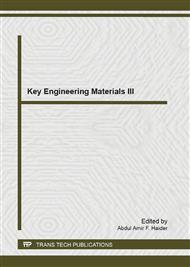[1]
H. Jin, Z. Chunxi and L. Gu: Direct dissolution of cellulose in NaOH/thiourea/urea aqueous solution. Carbohydrate Research. Vol. 342 (2007), pp.851-858
DOI: 10.1016/j.carres.2006.12.023
Google Scholar
[2]
Z. Yang and W. Pan: Ionic liquid: Green solvents for nonaqueousbiocatalysis. Enzyme and Microbial Technology. Vol. 37 (2005), pp.19-28
Google Scholar
[3]
S. Zhu, Y. Wu, Q. Chen, Z. Yu, Wang, S. Jim, Y. Ding and G. Wu: Dissolution of cellulose with ionic liquid and its application: a mini review. Green Chemistry. Vol. 8 (2006), pp.325-327
DOI: 10.1039/b601395c
Google Scholar
[4]
L. Qiang, Y-C.He, M. Xian, G. Jun, X. Xu, J-M. Yang and L-Z Li: Improving enzymatic hyrdolysis of wheat straw using ionic liquid 1-ethyl-3-methyl imidazolium diethyl phosphate pretreament. Bioresource technology. Vol. 100 (2009), pp.3570-3575
DOI: 10.1016/j.biortech.2009.02.040
Google Scholar
[5]
J.B. Binder and R.T: Raines Fermentable sugars by chemical hydrolysis of biomass. PNAS. Vol. 107 (2010), pp.4516-4521
DOI: 10.1073/pnas.0912073107
Google Scholar
[6]
D. M. Mousdale (2008), Biofuel: Biotechnology, Chemistry, and Sustainable Development. (CRC Press Taylor & Francis Group, 2008).
Google Scholar
[7]
MF. Demirbas: Bio-oils from corn stover via supercritical water liquefaction. Energy EducSciTechnol Part A. Vol. 23 (2009), p.97–104
Google Scholar
[8]
A. Demirbas: Competitive liquid biofuels from biomass. Applied Energy. Vol. 88 (2011), pp.17-28
DOI: 10.1016/j.apenergy.2010.07.016
Google Scholar
[9]
A. Demirbas: Biofuels sources, biofuel policy, biofuel economy and global biofuel projections. Energy Convers Manage. Vol. 49 (2008), p.2106–2116
DOI: 10.1016/j.enconman.2008.02.020
Google Scholar
[10]
I. Ozkurt: Qualifying of safflower and algae for energy. Energy EducSciTechnol Part A Vol. 23 (2009), p.145–151
Google Scholar
[11]
MF Demirbas: Microalgae as a feedstock for biodiesel. Energy EducSciTechnol Part A. Vol. 25 (2010), p.31–43
Google Scholar
[12]
S. Monavari, M. Galbe, and G. Zacchi: Influence of impregnation with lactic acid on sugar yields from steam pretreatment of sugarcane bagasse and spruce for bioethanol production. Biomass and Bioenergy. Vol. 35(7) (2011), pp.3115-3122
DOI: 10.1016/j.biombioe.2011.04.016
Google Scholar
[13]
P. Alvira, E. Tomás-Pejó, M. Mallesterosand M.J. Negro: Pretreatment Technologies for an efficient bioethanol production process baced on enzymatic hydrolysis: A review. Bioresource Technology. Vol. 101(13) (2010), pp.4851-4861
DOI: 10.1016/j.biortech.2009.11.093
Google Scholar
[14]
C.-Z. Liu, F. Wang, A.R. Stiles and C. Guo: Ionic liquids for biofuel production Opportunities and challenges. Applied Energy, Vol. 92(0) (2012), pp.406-414
DOI: 10.1016/j.apenergy.2011.11.031
Google Scholar
[15]
P. Mäki-Arvela, I. Anugwom, P. Virtanen, R. Sjöholm, J.P. Mikkola: Dissolution of lignocellulosic materials and its constituents using ionic liquids-a review. Ind.Crops Prod.Vol. 32 (2010), p.175–201
DOI: 10.1016/j.indcrop.2010.04.005
Google Scholar
[16]
Y. Fukaya, K. Hayashi, M. Wada, & H. Ohno: Cellulose dissolution with polar ionic liquids under mild conditions: Required factors for anions. Green Chemistry. Vol. 10(1) (2008),pp.44-46
DOI: 10.1039/b713289a
Google Scholar
[17]
S. Zhu: Perspective use of ionic liquids for the efficient utilization of lignocellulosicmaterials. Journal of Chemical Technology and Biotechnology. Vol. 83 (2008), pp.777-779
Google Scholar
[18]
M. Mazza, D-A.Catana, C.V-Garcia and C. Cecutti: Influence of water on the dissolution of cellulose in selected ionic liquid. Cellulose. Vol. 16 (2009), pp.207-215
DOI: 10.1007/s10570-008-9257-x
Google Scholar
[19]
P.S. Nigam and A. Singh: Production of liquid biofuels from renewable resources. Progress in Energy and Combustion Science.Vol. 37 (2011). pp.52-68
DOI: 10.1016/j.pecs.2010.01.003
Google Scholar
[20]
S. Beirão-da-Costa, A. Steiner, L. Correia, J. Empis, and M. Moldão-Martins: Effects of maturity stage and mild heat treatments on quality of minimally processed kiwifruit. Journal of Food Engineering. Vol. 76(4) (2006), pp.616-625
DOI: 10.1016/j.jfoodeng.2005.06.012
Google Scholar
[21]
C. Li, B. Knierim, C. Manisser, R. Arora, H. V. Scheller, M. Auer, K. P. Vogel, B. A. Simmons and S. Singh: Comparison of Dilute Acid and Ionic Liquid Pretreatment of Switchgrass: Biomass Recalcitrance, Delignification and Enzymatic Saccharification, Elsevier Ltd, Bioresource Technology. Vol. 101 (2010), pp.4900-4906
DOI: 10.1016/j.biortech.2009.10.066
Google Scholar
[22]
R. Abas, M.A. Kamarudin, A. Borhan, A. Nordin and M.A. Simeh: A study on the Malaysian Oil Palm Biomass Sector-Supply and Perception of Palm Oil Millers. Oil Palm Industry Economic Journal, Vol. 11(1) (2011), pp.29-41
DOI: 10.21894/opiej.2021.04
Google Scholar
[23]
V.I. Keffer, S.Q. Turn, C.M. Kinoshita and D.E. Evans: Ethanol technical potential in Hawaii based on sugarcane, banagrass, eucalyptus, and leucaena. Biomass and Bioenergy.Vol. 33 (2) (2009), p.247–254
DOI: 10.1016/j.biombioe.2008.05.018
Google Scholar
[24]
S. P. Ng. Francis: Tropical Horticulture and Gardening (MPH Publishing, Malaysia 2010).
Google Scholar


